|
Methods for chasing waveguide leaks vary; some may not be safe for systems or technicians
August 29, 2006 - In a perfect RF world, transmission lines and antennas that are pressurized with dry air or nitrogen to eliminate arcing and minimize corrosion caused by moisture will assist in providing a high quality signal and low VSWR for years to come.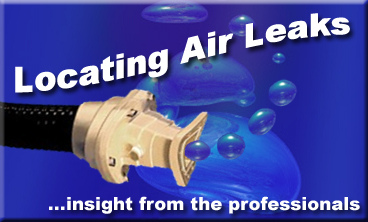
Unfortunately, there are more than a few operational pitfalls that can quickly shorten the life of the waveguide and RF system such as seam weld issues, blown antenna feed horns, defective O-rings and popped out pressure windows.
Add to those causes lightning, poor quality installations, birds with an insatiable appetite for pecking on copper and disgruntled hunters intent upon bagging a ferocious feed line, and you'll find empty nitrogen tanks and dehydrators that can't maintain pressure.
Finding an elusive leak can be an expensive time-consuming and difficult job and oftentimes the methods used aren't always the safest, say industry professionals.
Being sent up for scent of a woman is safer
One investigatory approach that has been employed over the years has been to use ethanethiol, commonly known as ethyl mercaptan, an organic compound used as an odorant in natural gas and propane. The colorless liquid is introduced into the pressurized line and a technician can easily identify the general area where the leak is coming from when the rotten egg smell from sulfur and skunk musk in the chemical is detected.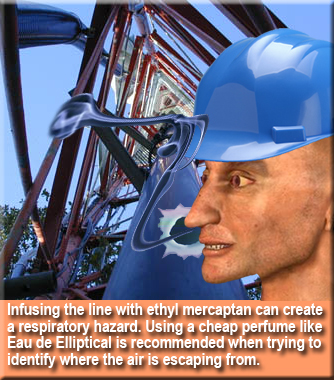
Ethyl mercaptan can be purchased for approximately $25, but there is a considerable amount of paperwork required to obtain the federally regulated chemical that is now receiving added attention by the US Department of Homeland Security regarding non-manufacturing companies that are requesting to buy it.
Identifying the amount to use in a transmission line is difficult since the recommended amount is one part per 50 billion parts of air for sensory detection. Exposure to too much ethyl mercaptan can cause serious respiratory effects to a climber, easily causing the technician to get headaches, lose coordination and possibly pass out from breathing the toxicant and fall from the structure.
Although cheap perfumes can be nauseating, some maintenance personnel say that they have been successful in detecting air leaks after they had doused a rag in perfume, inserted it in the line and then pressurized the waveguide.
Broadcast engineers cringe when they think about the explosive possibilities as they hear tales of technicians filling a system with natural gas or propane to find the leak and then purging the lines.
Non-flammable Freon refrigerant alternatives have also been used by some crews along with an ultrasonic leak detector to identify where there is a line, connector or antenna leak.
A WirelessEstimator.com forum contributor offered another alternative - use a stage production fogging canister to identify where major leaks are while viewing components from the ground with binoculars.
Non destructive testing preferred by manufacturers
It is not known what effect these processes have on the ability of the center conductor to displace heat as well as the possibility for RF reflections, and an increased return loss or arcing.
Transmission line and antenna manufacturers provide little information regarding how to locate difficult line leaks. At best they will suggest using a leak detection fluid and caution against introducing anything into an RF system other than nitrogen or dry air.
Kevin Reski, president of Great Plains Towers, explained to WirelessEstimator.com that in his many years of experience he has found that 90% of all air leaks are typically found in the transmitter building. Although he admits that it is difficult to get the broadcast engineer to assist you, "if it is possible to turn off all of the noise in the building and remove the feedline from the transmitter, ensuring that the nitrogen or dry air isn't flowing back into the transmitter through the inside of the gas stop connecter, you'll probably be able to hear where the leak is coming from."
Other maintenance professionals join Reski in preferring their hearing over their olfactory senses to find leaks.
By increasing nitrogen or dry air pressure they say they can hear the leak as they investigate larger lines on a tower. Although it may not be effective on smaller waveguide, or antennas that have a pressure release valve, they say it oftentimes works.
Soapy solutions are first choice for investigation
Soaping an RF system is the preferred method for most maintenance personnel for leak detection.
R. David Stiles, president of ProCom Towers International, Inc. of Chattanooga, TN, finds that using a half squirt spray bottle of Windex mixed with Dove liquid dish detergent provides the best results for searching for leaks, although he said that he's also had success with some bubble solutions purchased in toy stores. Some techs say that appliance parts distributors sell gas leak detector fluid that is more viscous than soap and holds a film on the surface longer.
Typically, soaping investigations will begin at the nitrogen tank or dehydrator unit with the system under pressure where valves, manifolds, polytubes and fittings will be checked.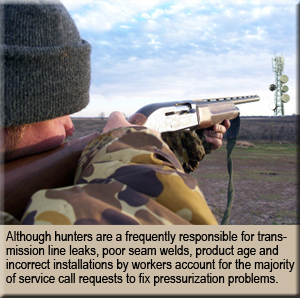
Charles "Chuck" Crizer, CEO of Crizer Brothers, Inc. of Alexandria, VA, says that the first places that he checks are the feed assembly and connection to the waveguide. Crizer points out that flexible waveguide is prone to leakage. He says that the hard rubber covering the flexible interface makes the leak seem to be at the flanges, but many times it is just escaping from the edge of the rubber.
Similarly, on transmission lines, Crizer cautions that a bubbling area is not always where the leak is, but is where it is being released. "Many times, the break will be quite a bit away and the gas is moving along the outside of the cable under the plastic covering," Crizer said.
After rounding up and investigating the usual suspects - feed horn seals, pressure windows, joint flanges - Crizer says if he can remove the RF from the system he will do a broad spectrum DTV measurement that may poinpoint where a problem is, a practice that will usually identify bullet, lightning and other major damage.
"Much can be said for a good visual inspection," Crizer explained. "See if the line looks strained or stressed. Is there a place where it could be vibrating or moving? Those are good places to check. If you have a good pressure gauge and can maintain a reading for a short period, try to move the waveguide and look for a sudden loss of pressure."
He also said that if you are working on rigid waveguide you can take apart the sections and trace to the fault.
Experienced technicians will sometimes cut a small piece from the jacket of a corrugated air line in one of the valleys of the copper near the back of the connector. If the solution bubbles at the end that spirals to the connector then it might indicate a bad seal. If it is at the end that heads towards the tower then there is a possibility that it is near the ground kit. The same technique can be utilized between the top connector and ground, but it is important to carefully clean the area and seal it carefully.
|
Dehydrators and nitrogen tanks
A waveguide system will incorporate a pressurizing source that provides dry gas on demand. It can be a regulated nitrogen tank or an automatic dehydrator. Both units are connected to the transmission line and recharges it to a preset positive pressure as required to compensate for leakage losses. 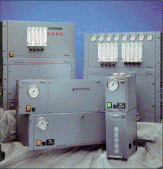
The newer, fully automatic membrane dehydrators are recommended for low to high system and purge volumes.
They are designed to cycle on and off, or run continuously in an emergency, providing a maintenance-free dry air system. Older "pressure swing" automatic dehydrators perform a similar function, but they do not provide the same trouble-free performance, low noise and vibration, and continuous drying capability the membrane units do.
For additional information, please see: Pressurization Fundamentals .
|
Placing QC on the back
burner causes problems
A great number of leaks result from poor installations. Ken McLeod, President of CSG Wireless Incorporated of Chandler, AZ, identifies poor installation as the major cause for transmission line leaks.
"In some cases, the transmission line is not installed in rubber donuts or installed properly and the mount rubs against the line. Wind and the natural vibration of the tower causes minute flexing of lines and over time you get chafing," MCLeod said.
The Arizona contractor says that over the years he has seen many lines so deteriorated that, "you could pour a bottle of soft drink into the hole."
He said that he has found that few dehydrators are being monitored off site.
Veteran field services manager Chas Wagner of Morrison Hershfield Corporation of Sunrise, FL, agrees with McLeod, citing improper installation as a primary cause of pressurization problems.
Wagner said that two of the most common causes for line leaks are from an incorrectly installed pressure window and poor routing of the waveguides at the dish.
"The pressure window should always be installed with the lens side towards the air source," Wagner explained. "This pushes the lens into the brass frame. If it is installed backwards the lens is pushed off of the frame, a very common mistake. Also, the gaskets used when installing a pressure window are different. A thinner gasket is needed; if placed on the wrong side it will seal in the connector's grooves and allow for a very slow leak that will be hard to detect, even with soapy water."
He said that the "stock" fat gasket will also have a tendency to roll or bunch when the connector's Allen bolts are tightened and result in a very noticeable leak.
Wagner has found that numerous waveguides have been replaced because the dish was not near its alignment azimuth when originally installed and the routing of the waveguide was too tight or was not given enough slack to travel during path alignment.
"This causes the waveguide to be stressed during the alignment and can cause a deformation of the waveguide conductor and crack or deform it, allowing for a leak. Oftentimes these cracks go unnoticed because the performance testing has been completed prior to path alignment," Wagner said.
Temperature probe can complement search
Identifying leak detection and transmission line burn outs on hard line systems with bolted flanges or large circular or rectangular waveguide can be accomplished by using an infrared thermometer gun, according to Stiles who specializes in broadcast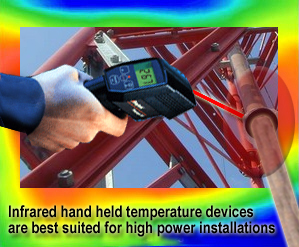 maintenance and installations. The gun can be purchased for approximately $300 and will detect leaks and arcing inside the waveguide by comparing temperature readouts. maintenance and installations. The gun can be purchased for approximately $300 and will detect leaks and arcing inside the waveguide by comparing temperature readouts.
"Since the RF inside of a line is heated by the process of transmission, it will also show up if leaking out of the flange or the transmission line," Stiles said.
This device is also helpful, Stiles explained, for detecting hot spots on large broadcast antennas if you use it only in extremely low power radiation conditions or get on the antenna just immediately after the antenna has been de-energized.
Infrared cameras can also provide thermal image displays that can precisely identify radiated energy. The thermographic imaging device enables the operators to produce temperature maps of the transmission line at any level, but the units can cost upwards of $2,500.
You've found it, now fix it
Tower technicians say that in most cases you can plug a small transmission line hole, repair a short slice in Heliax coaxial cable caused by rubbing hanger kits or fill a gap in a weld with a stick of steel reinforced plumber's epoxy putty. After wire brushing and coarsely sanding the damaged area you can mold the putty in place which will set steel hard in approximately 15 minutes.
Sometimes small holes can be carefully soldered, but with soldering or epoxy repairs it's important to ensure that copper flakes and any other foreign matter do not fall into the waveguide.
It is highly recommended to let the project engineer decide how extensively damaged lines or antennas are to be repaired.
|